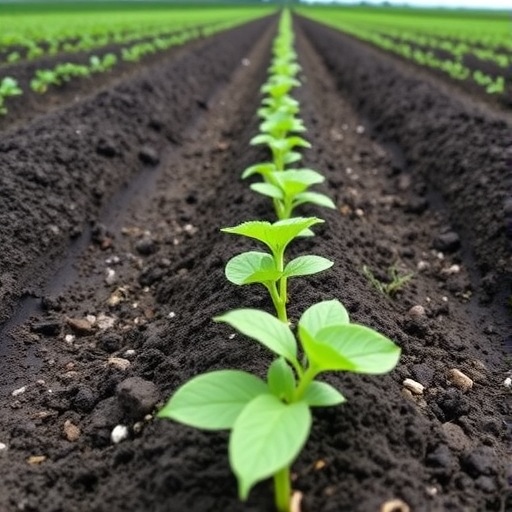A decade-spanning agricultural experiment has unearthed compelling evidence that biochar—a carbon-rich material derived from plant biomass—holds transformative potential for soil health and crop productivity in continuous soybean cultivation systems. This revolutionary study, conducted by researchers at Shenyang Agricultural University, meticulously evaluated biochar’s long-term effects on soil quality, microbial ecology, and soybean yield, offering a glimpse into a future where sustainable farming synergizes with cutting-edge soil science.
Over the course of ten years, experimental plots were subjected to two distinct biochar application rates, providing a rigorous comparison against conventional fertilization methods commonly employed in intensive agriculture. The biochar treatments yielded profound enhancements in soil physical properties, notably augmenting soil porosity and markedly reducing compaction. These structural improvements fostered enhanced aeration and water infiltration, key variables often compromised in monoculture systems, thus establishing a more favorable environment for root proliferation and microbial consortia activity.
Beyond the physical transformations, the study elucidated significant shifts in soil chemistry. Organic carbon content—a critical determinant of soil fertility—more than doubled in plots receiving higher biochar doses, highlighting biochar’s role as a persistent carbon sink. The amendment also rectified soil pH toward neutrality, optimizing nutrient solubility and availability, and reinstated balanced nutrient profiles by modulating key macronutrients such as nitrogen, phosphorus, and potassium. These chemical improvements not only rejuvenate depleted soils but also buffer them against acidification and nutrient imbalances induced by continuous cropping.
A particularly groundbreaking aspect of this research lies in the detailed characterization of biochar’s influence on the rhizosphere—the dynamic zone where plant roots and soil microorganisms interact. High-throughput sequencing and metabolomic profiling unveiled a restructuring of microbial assemblages; beneficial taxa including Firmicutes, Pseudomonas, and Mortierella flourished under biochar regimes. These microbes are renowned for their roles in nutrient cycling, pathogen suppression, and plant growth promotion, implying that biochar fosters a microbiome conducive to resilient agroecosystems.
Simultaneously, biochar modulated the chemical dialogue between roots and microbes by altering rhizosphere metabolites. Stress-induced compounds commonly associated with disease manifestation and soil degradation diminished significantly, while metabolites linked to enhanced plant defense mechanisms and growth stimulation increased. This intricate biochemical remodeling suggests biochar not only provides a habitat for advantageous microbes but also primes plants for heightened physiological and immunological responses—a dual effect that magnifies ecosystem health.
Plant phenotype responses to biochar were striking. Soybean plants in treated plots exhibited increased stature and robust root architecture, traits that underpin improved nutrient uptake and drought tolerance. Yield metrics reflected these physiological gains with staggering improvements; particularly, the higher biochar dose plots achieved a near 46% increase in soybean yield relative to conventionally fertilized controls. Such productivity leaps demonstrate biochar’s capacity to mitigate the deleterious effects of monoculture and soil degradation that traditionally challenge continuous soybean production.
Continuous cultivation of soybeans typically accelerates soil degradation and disease pressures, diminishing long-term viability without intervention. Conventional agricultural practices, relying heavily on synthetic fertilizers and pesticides, offer transient relief yet fail to restore or sustain soil vitality. This lengthy study offers an alternative paradigm: biochar as a regenerative amendment that enhances soil physical structure, chemical fertility, and biological integrity concurrently, thereby fostering systems resilience.
In their comprehensive analysis, the researchers emphasize biochar’s multifunctional role transcending mere soil amendment. It integrates into complex soil-plant-microbe networks, reshaping ecosystem interactions at molecular and community levels. This holistic enhancement illustrates biochar’s promise as a soil ecosystem engineer that cultivates both productivity and environmental stewardship, aligning with global imperatives for sustainable intensification of agriculture.
From an applied perspective, the findings hold substantial implications for farmers confronting the limitations inherent in continuous cropping systems. By incorporating biochar into their management practices, producers can expect improved soil health, reduced dependency on chemical inputs, and elevated crop performance. This aligns agronomic gains with economic incentives, potentially catalyzing widespread adoption of biochar technology in commercial agriculture.
Moreover, the environmental ramifications are significant. Biochar’s ability to sequester carbon within soil matrices contributes to climate change mitigation efforts, while its enhancement of soil biodiversity and function supports ecosystem services critical for long-term agricultural sustainability. This dual capacity reinforces biochar’s status as a tool for integrating food security with environmental responsibility.
The study’s robust design, spanning a decade and encompassing multidisciplinary analyses—from soil physics to microbial ecology and metabolomics—sets a high standard for future research. It demonstrates that long-term experimentation is pivotal to unveiling biochar’s full potential, capturing temporal dynamics often overlooked in short-term investigations.
As the global community grapples with escalating demands for food coupled with environmental degradation, this pioneering research advances a viable strategy for sustainable intensification. By concurrently improving soil structure, chemistry, and biology, biochar emerges not just as an amendment but as a cornerstone for resilient agricultural landscapes capable of supporting growing populations without compromising ecological integrity.
In conclusion, the decade-long investigation spearheaded by Shenyang Agricultural University’s team positions biochar as a transformative agent in the quest for sustainable continuous soybean production. Their findings beckon further exploration and deployment of biochar technologies worldwide, marking a pivotal step toward harmonizing agricultural productivity with environmental stewardship for generations to come.
Subject of Research: Not applicable
Article Title: Rhizosphere metabolite-mediated soil enhancement: long-term biochar application optimizes continuous soybean production systems
News Publication Date: 25-Aug-2025
References: Wu, D., Zhang, Y., Gu, W. et al. Rhizosphere metabolite-mediated soil enhancement: long-term biochar application optimizes continuous soybean production systems. Biochar 7, 95 (2025). DOI: 10.1007/s42773-025-00490-y
Image Credits: Di Wu, Yuxue Zhang, Wenqi Gu, Zifan Liu, Wenjia Wang, Yuanyuan Sun, Liqun Xiu, Weiming Zhang & Wenfu Chen
Keywords: Biofuels, Biochemical engineering, Bioremediation, Environmental remediation, Soil chemistry, Environmental chemistry, Soil science




